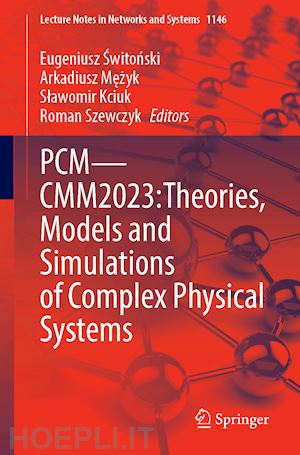
Questo prodotto usufruisce delle SPEDIZIONI GRATIS
selezionando l'opzione Corriere Veloce in fase di ordine.
Pagabile anche con Carta della cultura giovani e del merito, 18App Bonus Cultura e Carta del Docente
The idea of organizing the Polish Congress of Mechanics was born in 2005 among members of the Polish Society of Theoretical and Applied Mechanics. The first Congress has been organized in 2007. In 2013, the organization of the Polish Congress of Mechanics was included in the statutory tasks of the Polish Society of Theoretical and Applied Mechanics. Referring to the splendid tradition of Polish Theoretical and Applied Mechanics, the Congress has become one of the most important international scientific conventions representing this domain of science and gathering every 4 years about 500–600 specialists, who deal with the issues of mechanics and mechanical engineering in a broad sense.
The organization of the Congress allows for the connection of many scientific communities, researchers, and engineers from various universities, faculties, research centers, and institutions. Such scientific meeting is an excellent place for presentation, discussion, and dissemination of new achievements and ideas relating to the theoretical foundations as well as practical applications of mechanics.
The Congress presents the current state-of-the-art research in all disciplines of classical and quantum mechanics, solid and fluid mechanics, computational mechanics, applied mechanics, and physics, as well as structural mechanics and engineering.
Analysis of Elastic Wave Modes Sensing Using Piezoelectric and Fiber Bragg Grating Sensors.- Effect of Pumice Stone as a Coarse Aggregate Replacement on Lightweight Concrete Properties Using Response Surface Methodology.- Inspection of 2D Composite Structures Using Self-Heating-Based Vibrothermography.- Selected Aspects of Validation of Numerical Models of Bridge Structures in Terms of Dynamic Technical Diagnostics.- Influence of Lighting Column Wall Thickness on Passive Safety Coefficient During Car Crash.- Contact Phenomena of Soft Polymers – Insights From Experiments and Simulations.- Jaya Algorithm for Optimization of 2D Reinforced Concrete Frame Structure.- Specific Strength and Modulus of Epoxy Composites With Different Reinforcing Materials.- Modelling the Cooperation of Gravity Energy Storage With a Renewable Energy Source.- Elastic Force Sensor Based on Velostat® Characteristics Investigation.- Numerical Modeling of Tissue Laser Irradiation Using the Finite Pointset Method.- The Impact of Multilayer Composite Materials With a Duroplastic Matrix at Diversified Temperature Conditions.- The Implementation of Biomimetic Structural Optimization Software in a Supercomputing Environment.- Design of Electric Crawler Platform.- Development of Numerical Model To Simulate PM-FBG Response to Propagating Guided Waves.











Il sito utilizza cookie ed altri strumenti di tracciamento che raccolgono informazioni dal dispositivo dell’utente. Oltre ai cookie tecnici ed analitici aggregati, strettamente necessari per il funzionamento di questo sito web, previo consenso dell’utente possono essere installati cookie di profilazione e marketing e cookie dei social media. Cliccando su “Accetto tutti i cookie” saranno attivate tutte le categorie di cookie. Per accettare solo deterninate categorie di cookie, cliccare invece su “Impostazioni cookie”. Chiudendo il banner o continuando a navigare saranno installati solo cookie tecnici. Per maggiori dettagli, consultare la Cookie Policy.